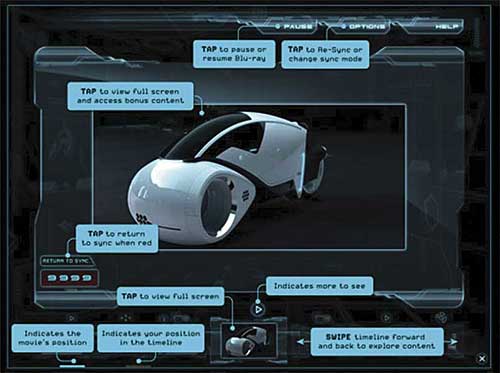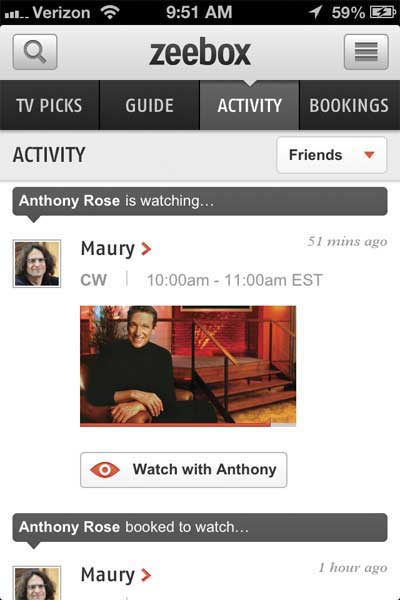The Rise of the Second Screen: Zeebox, GetGlue, Viggle, and More
ZEEBOX
Zeebox was founded in the U.K. in 2011, but it made waves in 2012 in the U.S. Using Twitter feeds, interactive polls, links to popular apps in iTunes, and zeetags -- its own version of the Twitter hashtag -- Zeebox is a polished, up-and-coming second-screen choice.
SOCIALGUIDE
SocialGuide was snatched up by Nielsen in the run-up to the major announcement with Twitter, but we still might see some surprises from its real-time trending tools for the second screen.
MISO AND CONNECTV
GoMiso.com is still positioning itself as a “making watching TV better” app, but it looks like it might be pivoting to
Quips, an app that lets you caption and share screen grabs from TV.
ConnecTV.com is attacking the second-screen app market by going local. Partnered with 10 major broadcasters, it launched out of beta in July by offering local interactive content while watching TV stations in your area. Time will tell whether the bottom-up approach beats the top-down approach taken by most in this space.
Unfortunately, there are so many apps out there right now that we can’t cover them all, but here is a list of a few more to keep an eye on:
Disney and Other Studio-Based Apps

Disney can be an innovator on many fronts, and embracing the technology for the second screen is no exception. For several years now, Walt Disney Studios has offered its Disney Second Screen app along with its Blu-ray movie releases. Titles with this feature include
Tron, The Avengers, The Lion King, Bambi, and
Pirates of the Caribbean: On Stranger Tides. The apps are free to download from iTunes for iPad and offer a continuous flow of behind-the-scenes information, director’s notes, photos, interactive elements, and supporting content. The flow of the content can be synced up by using audio, through a Wi-Fi-connected Blu-ray player, or by manually clicking. Most of the apps get good reviews on iTunes and appear to be popular additions to watching a Disney movie.
As a second-screen attractor, this is an excellent example on how to provide additional entertainment value. The only problem with apps such as these (created by content owners) is the lack of social interaction. There is no way to chat with my friends about Bambi or post my favorite Tron Light Cycle to Facebook. Other media companies face the same walled-garden issues when they provide single movie/show-based second-screen experiences. As we have seen in the examples given here, there are third-party companies ready to build up-to-date playgrounds for your viewers and their devices. The real trick for Disney and other companies will be if they can create relevant second-screen experiences that entertain and allow for socialization.
While Disney may be cranking out its own experiences, you can see how some of the competition is doing by looking at the following apps:
- MTV WatchWith
- VH1 Co-Star
- Syfy for iPad
- USA Anywhere
- Showtime Social
- AMC Mobile
The Future

The gaming industry has always provided insight into how we will create, publish, and consume content in the near future. From the days of “hacking” your graphing calculator to play snake to modern-day motion sensors that allow you to dance on your TV with One Direction, gaming has always pushed the boundaries with content and devices. The second-screen movement is no exception, and there are more than a few examples of how we will consume and interact with content in 2013 and beyond.
The most interesting examples of what could come are surfacing with the Microsoft Xbox 360 SmartGlass app and on the new Wii U gaming console from Nintendo. The Xbox 360 SmartGlass app is available on iOS, Android, and Windows Phone 8 and provides the perfect second-screen tether to your gaming console. See when your friends are gaming online, get interactive guides for your game, watch additional extras while enjoying a movie, and even use your phone or tablet as an extended controller. The new Wii U gaming console comes with its own tablet game controller and provides a wide array of interaction from watching Netflix to YouTube, chatting with your friends via video chat, or even playing games. It’s not surprising that we are seeing the future of entertainment when we look at gaming devices. After all, Nintendo DS has had a second screen since 2004.
In 2012 we saw the continued growth of social networks as power players in the world of TV. The number of third-party, second-screen apps skyrocketed, and while some faded away, were acquired, or pivoted, the market is still wide open for innovation. Traditional content companies launched their own apps and tools to engage viewers with moderate success. In 2013 the real winners will be the partnerships that form between content owners that bring the eyeballs on the primary screen and social startups that bring the typing fingers on the second screen.
This article appears in the April/May 2013 issue of Streaming Media magazine as "The Rise of the Second Screen."
Related Articles
Formerly known as GetGlue, TVtag offered second-screen activities for viewers, but couldn't build enough of a base.
22 Dec 2014